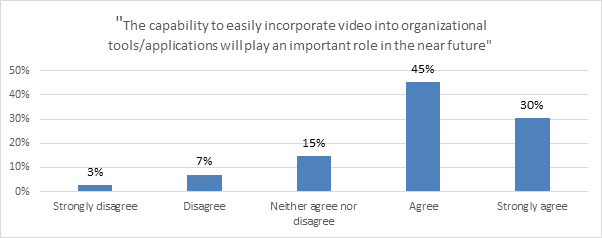With video seeming so pervasive in our lives, it is easy to forget how quickly its growth accelerated. And with users happily uploading video from their phones, there is an expectation of the same abilities to share and collaborate using video in the workplace. Yet there doesn’t always seem to be the same capabilities and support in a work environment to make this happen.
We decided to dig further and find out more about what’s actually happening. We undertook a survey to understand the extent of video use in the workplace, what it is being used for and the implications for marketers.
Certainly we found much evidence that employees appreciate the richness and hyper-engaging nature of video and there is high demand to use it more in the workplace.

CHART: 75% of respondents agree or strongly agree that “the capability to easily incorporate video into all of the organisations’ tools/applications will play an important role in the near future”.
Although video is still a relatively new medium for many organisations, it is on a fast upward trajectory. Our research indicates that employees already watch an average of seven hours of work-related videos per month. This is in line with Gartner’s predictions that employees will watch, on average, 16 hours of video at work each month by 2016 – equating to almost 45 minutes of video every workday.
At the high end, those organisations where video has been expertly deployed say that employees are already watching an average of more than 30 hours each month.
The power to create video is shifting from a centralised production team into the hands of users. A typical employee generates almost three hours of video per month. Indeed some organisations estimate that employees generate more than 20 hours video a month.
While content varies widely from professionally-produced marketing and brand promotion clips to employee-generated content, the most prominent uses are still external: marketing and brand promotion videos, product and product marketing videos, and training of customers, partners and integrators.
Our research indicates that 60% of companies surveyed use video for executive communications and 67% use video for events coverage. Meanwhile, at 60% of organisations surveyed employee-generated video is used for sharing best practices and how-to tutorials, while 66% use video for meetings. Interestingly, the use of video is now also emerging in the areas of help desk/customer service as a way of enhancing customer service, and in recruitment, for example for video interviews and video CVs (37% and 35% of respondents respectively).
The biggest perceived value is for knowledge sharing with a total of 95% seeing video as somewhat or very valuable. Other goals such as improving communications, connecting employees, enhancing product marketing and boosting employee creativity follow closely.
The use of video for marketing is certainly well understood with 66% of respondents agreeing or strongly agreeing that “including videos (optionally with call-to-actions) in marketing campaigns improves conversion rates”. Interestingly, 67% agree or strongly agree that “knowing the drop-off point from a marketing video could assist in lead scoring and qualification”. Those respondents in a marketing or sales role express this sentiment even more strongly.
The fact remains that with video becoming a dominant way of communication, it is a required and essential skill for employees. Indeed one Director of Digital Media Technology said: “Video will be considered a core competency, just like PowerPoint or Excel”.
On-demand video is still the most widespread form used, but live video has a significant presence too, particularly to connect employees, celebrating corporate culture and boosting employee creativity.
To harness the power of video, businesses are increasingly turning to standalone enterprise video portals (an ‘internal YouTube’ or ‘CorporateTube’), with 70% of respondents believing that a centralised location for all videos, which would facilitate video search and management, would avoid the curse of video silos.
When asked about what the future holds for video, respondents were very positive, as evidenced by the following comments:
“I see video creation and consumption growing in all areas of business. The tools for creation of videos are becoming more cost-effective, so organizations need to provide a vehicle for the creators to share their videos,” – Media Services Manager at a manufacturing organisation.
“I see it as one of the most powerful positive forces in large, international organisations, where currently the lack of interpersonal engagement between employees – especially within organic teams that are remote from one another – is harming collaboration. This is due to them not seeing one another and therefore not fostering trust or building those dynamics that breed relationships which are an important foundation for collaboration,” – Co-Founder of a training and consulting organisation.
In summary, this survey indicates that video will become pervasive within enterprises over the next few years. More organisations will follow the lead of today’s video-engaged organisations and reap the rewards of enhancing existing text-based experiences and creating new video-based work experiences.
For a copy of the report, please click here.





